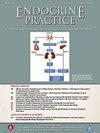A Predictive Model for Graves’ Disease Recurrence After Antithyroid Drug Therapy: A Retrospective Multicenter Cohort Study
IF 3.7
3区 医学
Q2 ENDOCRINOLOGY & METABOLISM
引用次数: 0
Abstract
Objectives
Predicting recurrence after antithyroid drug (ATD) cessation is crucial for optimal treatment decision-making in patients with Graves' disease (GD). We aimed to identify factors associated with GD recurrence and to develop a model using routine pretherapeutic clinical parameters to predict GD recurrence risk during the first year following ATD discontinuation.
Methods
This electronic health records-based observational cohort study analyzed patients with GD treated with ATDs at 3 U.S. academic centers. Demographic, clinical characteristics, and GD recurrence within 1 year following ATD discontinuation were assessed. Univariable and multivariable analyses were performed. A predictive model for GD recurrence was developed and visualized as a nomogram.
Results
Among the 523 patients included in the study, 211 (40.34%) discontinued treatment. Of these, the 142 (67.29%) that had a follow-up period exceeding 12 months after stopping ATD were used for the development of the predictive model. Among the patients included in the model, the majority were women (n = 111, 78.16%), with a mean age of 49.29 years (standard deviation 16.31) and baseline free thyroxine (FT4) levels averaging 3.39 ng/dl (standard deviation 2.25). Additionally, 79 of 211 patients (37.44%) experienced recurrence within 1 year. Multivariable analysis indicated a 31% increased risk of GD recurrence per additional decade of age (odds ratio 1.31, 95% confidence interval 1.03-1.66, P = .0258), and a 65% increased risk of GD recurrence for every 2.0 ng/dL rise in baseline FT4 (odds ratio 1.65, 95% confidence interval 1.08-2.50, P = .0192). The recurrence predictive model's area under the curve was 0.69 in the derivation dataset and 0.65 in cross-validation.
Conclusions
This study introduced a practical model that can be used during the initial therapeutic decision-making process. It utilizes easily accessible baseline clinical data to predict the likelihood of GD recurrence after 1 year of ATD therapy. Further research is needed to identify other factors affecting risk of recurrence and develop more precise predictive models.
抗甲状腺药物治疗后Graves病复发的预测模型:一项回顾性多中心队列研究
目的:预测停用抗甲状腺药物(ATD)后的复发对Graves病(GD)患者的最佳治疗决策至关重要。我们的目的是确定与GD复发相关的因素,并建立一个使用常规治疗前临床参数的模型来预测ATD停药后第一年GD复发的风险。方法:这项基于电子健康记录的观察性队列研究分析了美国三个学术中心接受ATDs治疗的GD患者。评估ATD停药后一年内的人口学、临床特征和GD复发情况。进行单变量和多变量分析。开发了GD复发的预测模型,并将其可视化为nomogram。结果:纳入研究的523例患者中,211例(40.34%)停止治疗。其中142例(67.29%)患者停用ATD后随访时间超过12个月,用于建立预测模型。在纳入模型的患者中,大多数为女性(n=111, 78.16%),平均年龄为49.29岁(SD 16.31),基线游离T4 (FT4)水平平均为3.39 ng/dl (SD 2.25)。此外,211例患者中有79例(37.44%)在一年内复发。多变量分析表明,每增加10岁,GD复发风险增加31% (OR 1.31, 95% CI 1.03-1.66, p = 0.0258),基线FT4每增加2.0 ng/dL, GD复发风险增加65% (OR 1.65, 95% CI 1.08-2.50, p = 0.0192)。递归预测模型在衍生数据集的AUC为0.69,交叉验证的AUC为0.65。结论:本研究提出了一种实用的模型,可用于初始治疗决策过程。它利用易于获取的基线临床数据来预测ATD治疗一年后GD复发的可能性。需要进一步的研究来确定影响复发风险的其他因素,并开发更精确的预测模型。
本文章由计算机程序翻译,如有差异,请以英文原文为准。
求助全文
约1分钟内获得全文
求助全文
来源期刊

Endocrine Practice
ENDOCRINOLOGY & METABOLISM-
CiteScore
7.60
自引率
2.40%
发文量
546
审稿时长
41 days
期刊介绍:
Endocrine Practice (ISSN: 1530-891X), a peer-reviewed journal published twelve times a year, is the official journal of the American Association of Clinical Endocrinologists (AACE). The primary mission of Endocrine Practice is to enhance the health care of patients with endocrine diseases through continuing education of practicing endocrinologists.
 求助内容:
求助内容: 应助结果提醒方式:
应助结果提醒方式:


